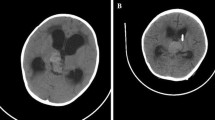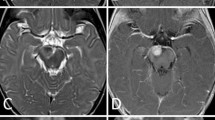Abstract
Background
Pineoblastomas are very rare brain tumors in fetus and neonates, comprising only 0.9% of congenital brain tumors. The occurrence of multiple tumors of different histopathologic types in the same individual is a rare event, most often encountered in hereditary cancer syndromes.
Case report
We report a female fetus presented with a congenital pineoblastoma at the 32nd week of gestation, with hydrocephalus and concurrent parameningeal embryonal rhabdomyosarcoma in early infancy.
Results
Cytogenetic analysis showed normal karyotype in the peripheral blood of the patient, and p53 mutational analysis revealed no germ line mutations.
Discussion
This is the first case with concurrent congenital pineoblastoma and parameningeal embryonal rhabdomyosarcoma in early infancy. We suggest that concurrence of these tumors could be due to mutations in other tumor suppressor genes or secondary to exposure to unknown in utero factors.






Similar content being viewed by others
References
Balestrini MR, Micheli R, Giordano L, Lasio G, Giombini S (1994) Brain tumors with symptomatic onset in the first two years of life. Childs Nerv Syst 10:104–110
Isaacs HJR (2002) I. Perinatal brain tumors: a review of 250 cases. Pediatr Neurol 27:249–261
Rickert CH, Porobst-Cousin S, Louwen F, Feldt B, Gullotta F (1997) Congenital immature teratoma of the fetal brain. Childs Nerv Syst 13:556–559
Isaacs HJR (2002) II. Perinatal brain tumors: a review of 250 cases. Pediatr Neurol 27:333–342
Jakacki RI (1999) Pineal and nonpineal supratentorial primitive neuroectodermal tumors. Childs Nerv Syst 15:586–591
Brockmeyer DL, Walker ML, Thompson G, Fults DW (1997) Astrocytoma and pineoblastoma arising sequentially in the fourth ventricle of the same patient. Case report and molecular analysis. Pediatr Neurosurg 26:36–40
Marec-Berard P, Jouvet A, Thiesse P, Kalifa C, Doz F, Frappaz D (2002) Supratentorial embryonal tumors in children under 5 years of age: an SFOP study of treatment with postoperative chemotherapy alone. Med Pediatr Oncol 38:83–90
Im SH, Wang KC, Kim SK, Lee YH, Chi JG, Cho BK (2003) Congenital intracranial teratoma. Prenatal diagnosis and postnatal successful resection. Med Pediatr Oncol 40:57–61
Mazouni C, Porcu-Buisson G, Girard N, Sakr R, Figarella-Ballanger D, Guidicelli B, Bonnier P, Gamerre M (2003) Intrauterine brain teratoma: a case report of imaging (US, MRI) with neuropathologic correlations. Prenat Diagn 23:104–107
Girard N, Raybaud C, Gambarelli D, Figarella-Ballanger D (2001) Pediatric MR neuroimaging. Fetal brain MR imaging. Magn Reson Imaging Clin North Am 9:19–56
Cho BK, Wang KC, Man DH, Jung HW, Kim HJ, Han DH, Choi KS (1998) Pineal tumors: experience with 48 cases over 10 years. Childs Nerv Syst 14:53–58
Oi S, Matsuzawa K, Choi JU, Kim DS, Kang JK, Cho BK (1998) Identical characteristics of the patient populations with pineal region tumors in Japan and in Korea and therapeutic modalities. Childs Nerv Syst 14:36–40
Diller L, Sexsmith E, Gottlieb A, Li FP, Malkin D (1995) Germline p53 mutations are frequently detected in young children with rhabdomyosarcoma. J Clin Invest 95:1606–1611
Merimsky O, Kollender Y, Issakov J, Bickels J, Flusser G, Gutman M, Lev-Chelouche D, Inbar M, Meller I (2001) Multiple primary malignancies in association with soft tissue sarcomas. Cancer 91:1361–1371
Khayat CM, Johnston DL (2004) Rhabdomyosarcoma, osteosarcoma, and adrenocortical carcinoma in a child with germline p53 mutation. Pediatr Blood Cancer 43:683–686
Stander M, Peraud A, Leroch B, Kreth FW (2004) Prognostic impact of TP53 mutation status for adult patients with supratentorial World Health Organization grade II astrocytoma or oligoastrocytoma. A long-term analysis. Cancer 101:1028–1035
Tsumanuma I, Sato M, Okazaki H, Tanaka R, Washiyama K, Kawasaki T, Kumanishi T (1995) The analysis of p53 tumor suppressor gene in pineal parenchymal tumors. Noshuyo Byori 12:39–43
Author information
Authors and Affiliations
Corresponding author
Rights and permissions
About this article
Cite this article
Çorapçíoğlu, F., Memet Özek, M., Sav, A. et al. Congenital pineoblastoma and parameningeal rhabdomyosarcoma: concurrent two embryonal tumors in a young infant. Childs Nerv Syst 22, 533–538 (2006). https://doi.org/10.1007/s00381-005-0006-2
Received:
Published:
Issue Date:
DOI: https://doi.org/10.1007/s00381-005-0006-2




